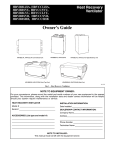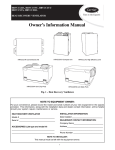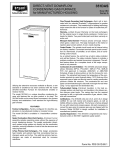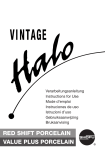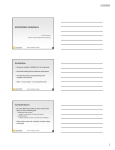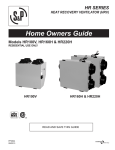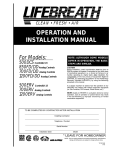Download Carrier VA3B, VA5B, VC5, VC5B Heat Recovery Ventilator
Transcript
VA3B, VA5B, and VC5B HEAT RECOVERY VENTILATOR User’s Information Manual for the Operation and Maintenance of Heat Recovery Ventilators 70 80 MODE 60 AIR EXCHANGE ´ ECHANGE D´AIR ON MARCHE 50 OFF LOW HIGH 40 AIR EXCHANGE ´ ECHANGE D´AIR 30 20 25 ´ RELATIVE HUMIDITY % D´ HUMIDITE ARRET 50 OFF LOW ARRET BASSE INTERMITTENT BASSE HAUTE 60 70 % HUM. RELATIVE HUM. 55% 45% 35% 30% EXT. TEMP. EXT. 10°C/50°F 0°C/32°F –10°C/14°F –20°C/–4°F 80 MAINTENANCE % HUM. RELATIVE HUM. 55% 45% 35% 30 30% 40 EXT. TEMP. EXT. 10°C/50°F 0°C/32°F –10°C/14°F –20°C/–4°F 25 20 ´ RELATIVE HUMIDITY % D´HUMIDITE Basic Control Standard Control Automatic Control Fig. 1 — Controls A94244 OPERATING YOUR HEAT RECOVERY VENTILATOR (HRV) Your HRV is designed to operate as an integral part of your total heating and cooling system. With the exception of high capacity models, which are available with standard controls only, all HRVs offer 3 control options (See Fig. 1.): • Basic Controls: Allow the user to manually set the unit to low- or high-fan speed as required to maximize comfort. Controls may be unit mounted. • Standard Controls: Offer automatic dehumidistat control and the option to select low speed or intermittent fan during heating season. • Automatic Controls: In addition to the operational features found with standard controls, automatic controls feature a recirculation mode. Not for use with forced-air HVAC systems. Fan Speed Control—Enables user to modulate fan speed from low to high. Dehumidistat Control—Allows the user to select the relative humidity level at which the unit would change fan speed to avoid condensation problems while heating during the winter months. TABLE 1 — HUMIDITY SETTINGS OUTSIDE TEMPERATURE °C °F DOUBLE-PANE WINDOWS TRIPLE-PANE WINDOWS (PERCENTAGE) (PERCENTAGE) 10 50 55 65 0 32 45 55 –10 14 35 45 –20 –24 30 40 –30 –22 25 35 Continuous Mode—If the relative humidity inside the building is lower than selected, air exchange would occur with the outside at low speed. If the relative humidity level inside the building is higher than selected, air exchange would occur outside at high speed. This ensures continuous air exchange for constant air quality. Intermittent Mode—If the relative humidity inside the building is lower than selected, no air exchange would occur, and the system would turn off. If the relative humidity inside the building is higher than selected, air exchange would occur with outside at high speed. This ensures minimum air exchange level when the building is unoccupied to minimize operating cost. Recirculation Mode—If the relative humidity inside the building is lower than selected, indoor air would be circulated and filtered at high speed. If the relative humidity inside the house is higher than selected, air exchange would occur with outside at high speed. This ensures continuous movement and filtration of air for maximum comfort. PERFORMING ROUTINE MAINTENANCE ! WARNING: Before servicing system, always turn off main power to system. There may be more than 1 disconnect switch. Turn off accessory heater power if applicable. Electrical shock can cause personal injury or death. ! CAUTION: Although special care has been taken to minimize sharp edges in the construction of your unit, be extremely careful when handling parts or reaching into the unit. 1. The motors are factory lubricated. Lubricating the bearings is not recommended. 2. The heat recovery core must be handled with care. To ensure maximum efficiency of the plastic partitions wash core once a year following the season of most intense use. Allow the heat recovery core to soak for 3 hr in a solution of warm water and mild soap. Rinse under a heavy stream of warm water. Hot water and strong detergent should NOT be used, as it will damage the heat recovery core. 3. A dirty air filter will cause excessive strain on the blower motor. The filters in your HRV are washable, and should be cleaned every 3 months. Use a vacuum cleaner to remove the heaviest portion of accumulated dust, then wash in warm water. The maintenance light on the auto control will indicate when filters should be cleaned. The light will stay on until the door is opened to service the unit. 4. Regularly check the screen on the exterior intake hood and clean as necessary. 5. Examine the condensate drain pan to ensure drains are functioning properly. Gently clean tray with mild soapy water. (See Fig. 2 and 3.) BEFORE YOU REQUEST A SERVICE CALL • Check the main power disconnect switch. Verify that the circuit breakers are ON or that fuses have not blown. If you must reset breakers or replace fuses, do so only once. Contact your servicing dealer for assistance if the breakers trip or the fuses blow a second time. • Check for sufficient airflow. Check air filters for accumulations of large particles. Check for blocked exhaust-air grilles or ductwork. Keep grilles and ductwork open and unobstructed. • If the condensate fails to drain properly, check the grommet and drain tube for obstructions. Make sure that the condensate drain tube has a slight slope and is not kinked. If your HRV still fails to operate properly, contact your servicing dealer. Give him your model and serial number. With this information, the dealer will be able to correct any problems. FRESH AIR FROM OUTSIDE STALE AIR TO OUTSIDE FRESH AIR TO BUILDING STALE AIR FROM BUILDING FILTERS ARE REMOVABLE BY PULLING STRAIGHT OUT BRIEF CASE TYPE LATCH DOOR IS DETACHABLE HEAT RECOVERY CORE CAN BE REMOVED BY PULLING STRAIGHT OUT CONDENSATE DRAIN A94263 A92382 Fig. 2 — Vertical Application Copyright 1998 CARRIER Corp. • 7310 W. Morris St. • Indianapolis, IN 6231 Form: OMVA3B-1 Cancels: OG-VA3B-01 Printed in U.S.A. Fig. 3 — Horizontal Application 7-98 Catalog No. 01VA-3B2


